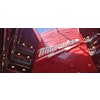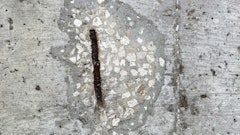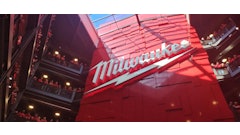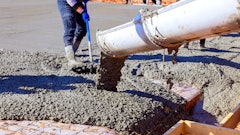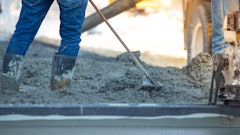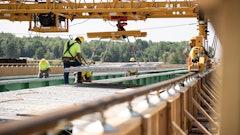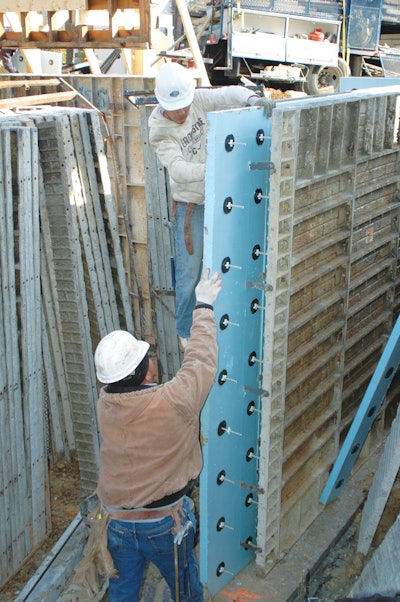
Buildings constructed with insulated concrete walls, like this one using the Thermomass insulation system in conjunction with removable form panels, can save energy costs
A wide range of sustainable benefits are made possible by concrete and other cement-based products. Beyond being gray and hard, how can concrete save energy, improve indoor air quality or enhance water quality? This list (provided by the Portland Cement Association) illustrates why more green-focused builders are becoming “Concrete Thinkers” and applying concrete solutions to innovative sustainable designs:
- Concrete reduces sound penetration: The greater mass of concrete walls can reduce sound penetration through a wall by more than 80% compared with wood or steel frame construction.
- Concrete recycling improves manufacturing process: Concrete can be readily recycled and reused as base materials for roads, sidewalks and slabs, sparing the use of virgin materials. In concrete’s life cycle, recycling is present from the beginning. For example, many wastes and industrial byproducts, like fly ash (a byproduct of coal combustion at electric power utility plants) that would otherwise clog landfills, can be added to concrete mixes. These by-products also reduce reliance on natural (virgin) raw materials. According to the American Coal Ash Association, in 2007 the concrete industry used 17 million metric tons of fly ash. Finally, when a concrete structure has served its purpose, it can be recycled as aggregate in new concrete paving, backfill or as road base. Even the reinforcing steel in concrete can be recycled and reused.
- Concrete improves energy efficiency: Building components constructed of concrete are generally considered mass elements, which means they have enough heat-storage capacity to moderate daily temperature swings. Buildings constructed of cast-in-place, tilt-up, precast concrete, insulating concrete forms (ICF) or masonry possess thermal mass that helps moderate indoor temperature extremes and reduces peak heating and cooling loads. In many climates, these buildings have lower energy consumption than non-massive buildings with walls of similar thermal resistance. When buildings are properly designed and optimized, incorporating thermal mass can reduce heating, ventilating and air-conditioning equipment capacity. Reduced equipment capacity can represent energy and construction cost savings – as much as 25% in some cases.
- Concrete is resilient: Long service life and disaster resistance maximizes all the attributes of sustainable construction. Concrete stands up to the fury of nature and will not rust, rot or burn. It is the most widely used building material in the world and concrete buildings have withstood the test of time for more than 2,000 years. When properly designed, concrete buildings can be reused or rebuilt. Although a concrete building may begin its life as an industrial building, it might be renovated into office space or housing. The reuse attributes of concrete conserves future building materials and reduces the construction time new structures may require. New concrete mix designs have also been developed that minimize the amount of cement required while maximizing the use of alternative materials. No one concrete mix is applicable to all situations, but with the correct proportions of fly ash, recycled aggregate, slag and other materials, quality concretes are now more durable than concrete produced in the past.
- Pervious concrete is a benefit: Pervious concrete allows rainwater to naturally filter through it, preventing deposits of oil, grease and contaminants from entering storm drains and the water supply. This technology is recognized by the EPA as a best practice for stormwater management.
- Concrete keeps you warmer/cooler: With energy costs on the rise, this winter promises to be costly for consumers. Buildings with exterior concrete walls, also called mass walls, utilize less energy to heat and cool than similarly insulated buildings with wood or steel frame walls.
- Decorative concrete provides beauty that lasts: Using decorative concrete limits finishing materials and harmful VOCs (volatile organic compounds) and provides a high-quality, durable, low-maintenance surface.
- Concrete makes virtually any design possible: Concrete is a versatile material that can create any shape or size building, from big box retail centers to elegant building spires.
- Concrete is cool: Concrete minimizes the effects that produce urban heat islands. Studies have shown that urban environments have higher temperatures in areas where there are few trees and many dark-colored, paved surfaces and buildings. This additional heat causes air conditioning systems to work harder, which uses more energy (up to 18% more), promoting the formation of smog. Light-colored concrete absorbs less heat and reflects more light than dark-colored materials — thereby reducing heat gain. Light colored pavements also require less site lighting to provide safe night illumination, whether on parking lots, driveways or sidewalks.


